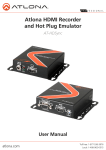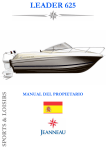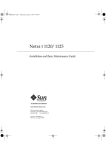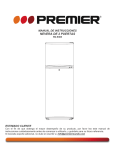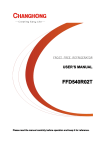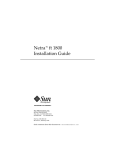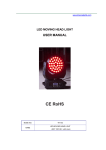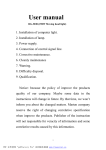Download Changhong Electric FSR120R02W User`s manual
Transcript
BAR FRIDGE USER’S MANUAL FSR121R02B FSR120R02W Read the manual carefully before operation and keep it for reference. This manual is only for reference, please comply with actual appliance you selected. manufacturer hold the authority to redesign or modify its products without notice. NAMES OF THE PARTS 6 1 7 2 3 4 5 8 1. Ice Box Door 2. Water tray 3. Refrigerator Shelf 4. Crisper Cover 5. Crisper 6. Pocket Rack 7. Thermostat 8. Bottle Rack WARNING: Never touch the interior of the Freezer or frozen foods in the compartment with wet hands as this could result in frost bite. 1 IMPORTANT SAFETY INSTRUCTIONS WARNING To reduce the risk of fire, electrical shock, or injury when using your refrigerator, follow these basic precautions: Read all instructions before using the refrigerator. DANGER or WARNING: Risk of child entrapment. To avoid the possibility of child entrapment, please take the following precautions before throwing out the refrigerator. - Remove all doors from the unit. - Leave the shelves in place so that children may not easily climb inside. Never allow children to operate, play with, or crawl inside the refrigerator. Never clean refrigerator parts with flammable fluids. The fumes can create a fire hazard or explosion. Do not store or use gasoline or any other flammable vapors and liquids in the vicinity of this or any other refrigerator. The fumes can create a fire hazard or an explosion. - Please read and save these instructions - * The appliance should be so positioned that the plug is easily accessible. * If the supply cord is damaged, it must be replaced by a special cord or assembly available from the manufacturer or its service agent. * The appliance shall not be used in open air and shall not be exposed to rain. * Don't store something like ether methanol, gasoline etc. which is easy to evaporate burn or explode. * Don't set something too heavy on the top of refrigerator and do not pour water on it. * Connect your refrigerator to an independent electrical socket and use a safe ground wire. * Turn on electricity only 5 minutes later after electricity goes off. Otherwise, the compressor may be damaged. * In order to save electricity consumption, keep air circulation during operation and the package base should be taken away. * Be sure to keep electrical wire away from compressor and condenser, or its insulation function will be spoiled by high temperature. * To save the energy, you should reduce the frequency and duration of the opening of the door. * When the frost in chilled room is removed, or where there is no electricity or when refrigerator ceases to be used, it should be cleaned in time in order to prevent it from smelling. Too much frost may affect refrigeration. * Do not touch the food in the freezer box or container (especially metal container) with wet 2 hands, or it may be frosted. * Do not use the prolonged power cord. * If the appliance can’t be used any more, please release the refrigerant before abandon at a place exposed to the air and away from tinderbox. This appliance is not intended for use by persons (including children) with reduced physical, sensory or mental capabilities, or lack of experience and knowledge, unless they have been given supervision or instruction concerning use of the appliance by a person responsible for their safety. Children should be supervised to ensure that they do not play with the appliance. R600A WARNINGS NOTE: This model uses 0.024Kg of R600A flammable refrigerant in its sealed system. The following must be observed for your safety: R600A Refrigerant Warning • This appliance contains a small quantity of R600A refrigerant which is environmentally friendly, but flammable. It does not damage the ozone layer, nor does it increase the greenhouse effect. • During transportation and installation, ensure that the tubing of the refrigerant circuit is not damaged. • Leaking refrigerant can ignite and may damage the eyes. • In the event any damage does occur, avoid exposure to open fires and any device which creates a spark. Disconnect the appliance from the mains power. • Thoroughly ventilate the room in which the appliance is located for several minutes. • Notify Customer Service for necessary action and advice. • The room for installing the appliance must be at least 1 cubic metre per 8 grams of refrigerant. The refrigerant quantity contained in this appliance is listed above in grams; it is also noted on the Rating Plate of the appliance. It is hazardous for anyone other than an Authorised Service Person to carry out servicing or repairs to this appliance. In Queensland the authorized person must hold a Gas Work Authorisation for hydrocarbon refrigerants, before carrying out servicing or repairs which involve the removal of covers. –WARNING: Keep ventilation openings, in the appliance enclosure or in the built-in structure, clear of obstruction. –WARNING: Do not use mechanical devices or other means to accelerate the defrosting process, other than those recommended by the manufacturer. –WARNING: Do not damage the refrigerant circuit. –WARNING: Do not use electrical appliances inside the food storage compartments of the appliance, unless they are of the type recommended by the manufacturer. 3 The environment and personal safety must be considered when disposing of this appliance. Please ensure the appliance is taken to a recycle center for safe recycling. DO NOT dispose of the appliance in land fill as the insulation and refrigerant gas contained in these appliances are flammable. Warning: 1. Keep ventilation openings in the appliance enclosure or in the structure for building in clear of obstruction. 2. Do not damage the refrigerant circuit. 3. Do not use electrical appliances inside the food storage of the appliance unless they are of the type recommended by the manufacturer. • Transportation and Handing When transporting, hold the base and lift the refrigerator carefully with the angle more than 45 degree. Never hold the door handle as support. Never place it upside down horizontal wise. • Installation 1. Install the refrigerator at a place with a flat, firm ground directly to prevent vibration and noise. 2. Choose a well-ventilated place. A space of no less than 10cm must be left around the refrigerator. Especially for the back of the fridge, it should be no less than 13cm space to wall. 3. Choose a location where there is no heat source. Keep the refrigerator away from direct sunlight and oven etc. 4. Choose a dry and well-ventilated place where there is no corrosive air. • Testing 1. Clean the parts of the refrigerator with lukewarm water containing a little neutral detergent and with clear water, and wipe them dry. Notes: Electric parts of the refrigerator can only be wiped by dry cloth. 2. Turn the thermostat knob to the "3" position, turn on electricity. The compressor and the light inside the refrigerator begin to work. 3. Open the door 30 minutes later, if the temperature in the refrigerator decreased obviously, it shows that the refrigerator system works well. When the refrigerator operates for a period of time, the temperature controller will automatically set the temperature within limits it 4 opens. • Temperature Control 1. The temperature in the refrigerator compartment is controlled by the temperature controller installed on the side wall of the refrigerator compartment. 2. Turn the thermostat knob to right or left, you can regulate the temperature inside the refrigerator. 3. The marks on the knob are the temperature grades, not the exact number of the degrees of temperature. "OFF" shows a forced STOP and "7" shows the lowest temperature. Turn the knob from "1" position to "7" position, the temperature decreases continuously. You may set the temperature control selector to any position according to what you need. 4. Please set the selector to "4"position in normal use. • Storage of Food Chilled Room * Put fresh and clean food such like fish, meat into ice room, therefore the taste and nutrient of food are preserved. * Wrap food to be frozen in ALUMINIUM FOIL or place it in AIRTIGHT boxes. * Do not allow already frozen food into direct contact with food to be frozen. * If you buy deep frozen food in the shops, bring it home and place it in ice room as quickly as possible so that the time during which it kept in the air temperature is as soon as possible. Refrigerator Compartment * The cook dishes can be put into refrigerator to keep fresh after their temperature decreases to room temperature. * Egg pockets and bottle pockets for eggs, butter, milk and bottle drinks etc. * Vegetable box for fruits, vegetables, etc (the cover on the vegetable can keep the water from evaporating). Placement of Food * Proper place should be left instead of too crowded during food storage. * Food to be stored should be wrapped with clean plastic film or fresh keeping paper, then distributed to several frames even to avoid contamination and the loss of water and smell mixture. * Cool hot food down to the room temperature before storing or consumption of electricity will increase and would lead to frost forming inside. * Never place vegetables and fruits into ice room in order to prevent them from being frostbitten. 5 • Defrosting 1. When the refrigerator working for a period of time, the inner surface of the chilled room will be covered with a layer of white frost. It may raise the electricity consumption and lessen the effect of refrigeration. Then you should do a manual defrost at once. 2.When defrosting, cut off the power ,open the door and move frozen foods to a shady and cooling place, defrost with a plastic scraper, or let the temperature rise naturally till frost mel ts. Then wipe away remaining ice and water, and switch on electricity again. Notes: Never use sharp metal tools or it will damage the refrigerator. CARE AND MAINTENANCE INSTRUCTIONS • The refrigerator should be cleaned every month, the electric plug must be removed from the power supply before cleaning. • Wipe the inside and outside of the refrigerator with a wet soft cloth. If it's dirty, clean with a soft cloth soaked with neutral detergent and clean water, remove the moisture with dry cloth. • If you have to leave the refrigerator not in use for a period of time, proceed as follows: 1. Disconnect the refrigerator from the electric power supply by removing the plug from the wall socket. 2. Remove all food. 3. Clean and dry the inside as instructed in the direction given above for cleaning. 4. Leave the doors open to prevent any unpleasant smells from building up while the refrigerator is not used. • Cleaning 1. When cleaning the refrigerator the electric plug must be removed from the power supply. 2. Use water and a non abrasive detergent. 3. Clean with a soft cloth soaked in this solution and remove moisture with a dry cloth. • Replacing the light bulb The plug must be disconnected from the main supply. Remove the light cover by squeezing the top and bottom faces together sufficient to disengage the lugs. Replace the bulb. Replace cover. 6 TROUBLESHOOTING GUIDE You can solve many common refrigerator problems easily, saving you the cost of a possible service call. Try the suggestions below to see if you can solve the problem before calling for service. PROBLEM POSSIBLE CAUSE Appliance will not work at all Noisy running Appliance does not cool sufficiently Smell inside the appliance The power supply plug is not inserted in the wall socket or the plug and the outlet is loose. Due to some anomaly in the household electric supply circuit, no power is reaching the refrigerator supply socket. This can be checked by plugging in a light or any other electric appliance into the suspect socket. The voltage is too low. The appliance has not been properly level. The refrigerator contact with the wall. The accessories in the refrigerator are placed wrong position. Door has been opened too often, or it has been left open for a while. The refrigerator is too near to the wall. Too much food in the refrigerator. Have not regulated the temperature correctly. Some of the food is not properly wrapped or covered. The inside of the refrigerator needs cleaning. Normal phenomenon: 1. Refrigerant running in pipes gives forth a gentle sound of water running in pipes. 2. In a moist season, the outer surface of refrigerator may be covered with moisture which should be simply wiped away. 3. The compressor may be heated to the extent that scalding your hand in summer during refrigerator operation. Specifications and operation are subject to change without notice. Any other enquiry, please call our service centre as: 1300 796 688. 7 8









